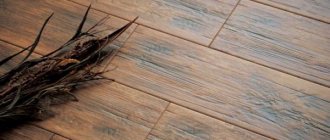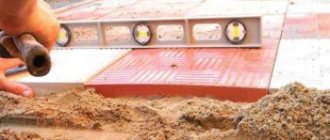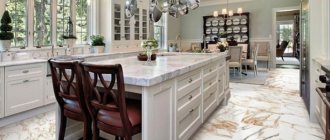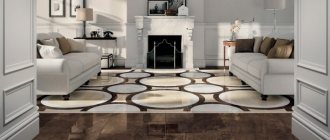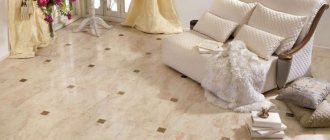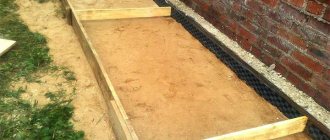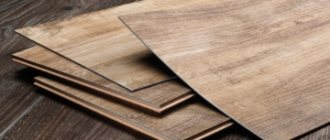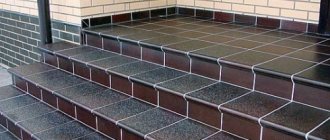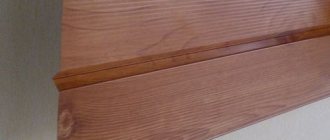Wood-look porcelain tiles (imitating parquet or boards) for laying on the floor combine the strength of stone and the beauty of natural wood. When choosing a floor covering, you should be guided by the general style decision. The use of natural materials in interior decoration is always relevant. Wood-look porcelain tiles combine the strength of stone and the texture of wood, thereby creating a warm and cozy atmosphere in the room.
Attention! Ceramic coating, despite its external resemblance to wood, is cold. Therefore, during installation, it is recommended to equip a heated floor system, which will allow you to control the degree of heating of the floor covering depending on weather conditions.
Yew, oak or ash? Simulation options
During the manufacturing process, a thin wood-like pigmented layer is applied to the porcelain stoneware blank, which gives it the appearance of parquet or boards.
Porcelain tiles are very similar in color and texture to wood fibers
Modern technologies make it possible to recreate any pattern on the tile surface that imitates the texture of wood:
- oak;
- larch;
- yew;
- ash;
- exotic trees.
At the same time, some manufacturers maintain the dimensions of products similar to those made from natural materials. For example, for greater external similarity with imitation wood, tiles can be produced not only in a standard format, but also in the form of parquet and planks.
Porcelain tiles can imitate different types of wood
In this way, it is possible to recreate both the color and shape of wooden block parquet or parquet boards.
The use of porcelain stoneware in home interiors
To get the desired effect when decorating the interior, you need to select the color of porcelain tiles to match the wood, taking into account the following factors:
Porcelain tiles in the living room
- general interior style;
- room lighting;
- geometric dimensions and architectural features.
Advice! To visually increase the space, use imitation birch or pine with a dim or blurry texture. For hallways and large halls, wood-look porcelain tiles with a tint of cherry or stained oak are suitable, and for the kitchen, a surface imitating pear, alder, walnut or mahogany wood would be an excellent option.
The most popular options for home are:
- oak;
- exotic breeds;
- yew;
- ash;
- larch.
Porcelain stoneware is a highly durable finishing material, the service life of which significantly exceeds even noble wood species. In addition to high strength, the tile is considered safe for health, since it uses natural ingredients. Therefore, its use is justified in a home environment.
Area of use of wood-effect porcelain stoneware
The main advantage of porcelain stoneware is zero water absorption, due to which it is successfully used in finishing floors and walls in the bathroom, kitchen and other rooms exposed to increased influence of moisture. The highly durable material will last decades longer than any wooden flooring.
This material has also become widespread in the decoration of stairs. The design using stained wood porcelain tiles looks very original, as well as other design options for stair steps that make them stand out against the background of the general floor covering.
You can use porcelain tiles to finish floors and walls in any room, as well as outdoors
Porcelain tiles, in addition to being installed in the bathroom and kitchen, are also popular for finishing public spaces. In this case, the material is subject to increased requirements for abrasion, or an imitation of wood with a relief pattern is selected, the surface of which is polished or glazed.
Advice. Using porcelain tiles with wood imitation, you can also decorate the fireplace room in an original way. In this case, it can be used to cover the entire floor area or only fragmentarily in the fireplace area, which will eliminate the possibility of fire in this area.
Tips for laying “wood” porcelain tiles
Structured, high-quality cladding is perceived as a natural mass. Therefore, when installing, the following rules must be observed:
- Before installing porcelain stoneware, it is necessary to prepare the base - it must be perfectly level. Even minor differences in height are not allowed.
- Floor markings are carried out depending on the chosen installation method.
- For adhesion to the floor surface, it is better to use specialized one-component and two-component compounds.
- It is recommended to lay porcelain stoneware using the deck method, when the rows are shifted by 1/5 or 1/6.
Due to the displacement along the length, the coating looks like a laminate. Also, the classic herringbone method is often used for styling. Less commonly used are “versailles”, “frame”, “well” and “four rocks” masonry.
Skillful installation and the use of high-quality finishing materials will allow you to obtain a coating that is difficult to distinguish from wooden boards. Considering the performance characteristics of porcelain stoneware, we can conclude that it is a rational alternative to expensive and demanding wood.
Choice of colors for wood
Modern wood-look porcelain floor tiles are offered in a wide range of all possible colors and shades. Products can be polished or matte in color, of almost any texture, and can imitate piece, decorative and artistic parquet, solid wood, laminate, etc.
Using porcelain tiles you can create the illusion of parquet or laminate flooring
In modern bright interiors, porcelain stoneware flooring looks great under parquet boards in wenge or milky oak color. If this is required by the overall style decision, you can easily choose the opposite option by choosing porcelain tiles that imitate a worn “antique” surface.
The maximum resemblance to natural wood is conveyed by porcelain tiles with a textured coating. Texture can be created by structuring, when the material under pressure takes the form of a cast taken from real boards or parquet flooring. A more pronounced shade is imparted using glazing, porcelain stoneware or clay cladding - such a floor covering will be practically indistinguishable in appearance from the original.
Designer delights
The texture will no longer surprise anyone. But if you have bright decor in front of you, successfully complemented by dimensions, this is a completely different matter. Based on the nature of the surface finish, porcelain stoneware can be divided into 5 groups:
Classic or aged parquet (rustic, antique)
Copies a standard floor laid in “deck”, “herringbone”, “squares”, etc. Moreover, it is produced both in the form of small elongated dies and in the form of square plates with a narrow parquet floor pattern applied, as in the photo below.
By the way, the seams can be treated with grout of one color or, conversely, a contrasting one. But you need to choose shades carefully. For example, white porcelain tiles with brown or black jointing look sloppy. It is better to buy gray or milky. But the coating of dark tones goes well with light seams.
Floor board with orthogonal or tangential cut
The size range of products in this group is extremely wide. The length can reach 3 m, width – 12-90 cm, thickness – 5-18 mm. It is thanks to this variety that porcelain tiles designed to look like parquet or solid boards can be successfully used for finishing walls or floors. The decorative part perfectly imitates all types of surfaces:
- new lacquered coating, which is achieved by polishing and rectifying the edges;
- classic untreated plank flooring with a matte surface and texture that replicates natural wood “in register”. An excellent solution for interiors in country, neo-classic, modern and loft styles. With a professional approach, it can even be used in high-tech and minimalist solutions;
- brushed parquet board matte or semi-matte. Porcelain tiles with such decor are often used in themed clubs, restaurants, and in combination with a floor heating system - in living rooms, libraries, billiard rooms, offices and even bedrooms;
- vintage floor finish. The collections of this series embody such an interesting style as shibby chic, characterized by multiple abrasions, chips, remnants of old paintwork, and inscriptions. Particular emphasis is placed on decorative edge work, which reduces the impact of seams on the overall impression of the floor; .
Shibby chic
Shibby chic - antique solid wood in the Recycle Wood style is a fashion trend that has captured the minds of designers of all flooring materials, from parquet to linoleum. This is not artificially aged wood, but a coating made from old wood that has been used more than once. Each product is deeply textured and has a rich palette of shades in sometimes completely unexpected combinations.
According to professional decorators, boards are the most rewarding material. It is easy to work with such a coating and create something new and unique. For example, you can make a classic “deck” or an enlarged “herringbone”, zone the room with a play of textures, shades or dimensions, arrange a floor made of different materials in one room (for example, terracotta and floorboards, granite and parquet).
Wooden mosaic standard and 3D (block parquet)
Available in 2 types:
- small dies with smooth geometric or chaotic edges. Labor-intensive, but very effective flooring material for rooms with complex geometry;
- large-format slabs with mosaic floor decor. In this case, the dividing seam between the elements is not just drawn, but deeply cut. Thanks to this design technique, the floor turns out to be uniform and solid.
The thickness of the products is usually small - 5-8 mm, so they can be used on horizontal and vertical surfaces at the same time.
Palace or type-setting parquet
One of the most beautiful decorative techniques with a rich set of ornaments is squares, “stars”, inlays made of valuable wood, small stone inserts. Designs for artistic laying of planks on the floor cannot be called boring, which is why they are very popular in linoleum, laminate and ceramics. Manufactured:
- standard tiles with smooth edges 33x33, 40x40 cm, 45x45 cm, 60x60 cm, etc.
- large-format elongated planks up to 60 cm wide and up to 120 cm long.
OSB, chipboard, plywood
When they see tiles with the texture of wood boards, many buyers simply refuse to believe their own eyes. However, some eminent designers are attracted by the unique beauty of the mosaic surface of oriented strand or plywood sheets. Therefore, European and Russian manufacturers can find such unusual material in their assortment. In terms of its quality characteristics, ceramic tiles are in no way inferior to their analogues, and accordingly, they have a right to exist.
For all of the above groups of porcelain tiles, all kinds of decoration techniques are used: mosaics, imprinting of various patterns, painting using graffiti or burning techniques, inscriptions, painting with Moroccan, Mezen, Tunisian ornaments, etc.
Of course, for each collection, regardless of design and size, a set of various decorations is produced: decorative tiles, panels, inserts, borders and other elements.
A chamfer is worthy of special consideration - a V- or U-shaped micro-recess along the perimeter of one element. Its purpose is to make porcelain stoneware even more similar to a natural board, to create a visual effect of some volume and depth. It is used in the production of cladding for standard or artistic parquet and floorboards. Its only inconvenience is that when laying large-caliber slabs (from 45x45 and above) on the floor with untreated edges, a fairly wide seam is formed - more than 2 mm. It seems to blur the chamfer, reducing the decorative effect to zero.
The best collections and manufacturers
The leading positions in the production of porcelain tile flooring imitating wood are occupied by Spain and Italy. Collections of famous brands Del Conca, Marazzi, Grespania, Fondovalle or Oset are distinguished by truly high quality, which the manufacturing companies monitor most carefully.
Porcelain tiles TM Del Conca
The Italian brand Inside Ceramica Fioranese deserves special attention - porcelain tiles from this series imitate prefabricated modules made of wooden blocks. The color and texture of natural parquet is provided by Montreal Venis from a manufacturing company from Spain.
When choosing porcelain tiles to match aged vintage wood, you should take a closer look at the Vintage Astor collection or Royal Sant'Agostino from Italy. In the latter case, the wood has not only stood the test of time, but also imitates hand-assembled antique floors and brushing - to achieve these effects, the manufacturer used digital printing on ceramics.
Porcelain tiles from the Vintage Astor collection
The Spanish Nuss Roca collection, stylized as parquet, or the Italian Playwood Fondovalle, demonstrating complete similarity with exotic hardwoods, will look incredibly stylish in the interior, but will not be cheap. You can save money by choosing products from a domestic manufacturer, which also offers porcelain tiles of different sizes, colors and types of processing (polished, matte, etc.).
How much does this tile cost?
Not so long ago, the cost of porcelain tiles was prohibitive, and not everyone could purchase them. Considering the complex installation of the material, the cost of a good craftsman and the installation of a heated floor, the budget turned out to be quite impressive, and there was no point in spending a lot of money on tiles. Moreover, a conscientious craftsman could always recommend other high-quality and inexpensive alternative materials.
Currently, porcelain stoneware has become more affordable, and designers are already using it more actively when organizing interiors. The main disadvantage of porcelain tiles - price - is explained by their high quality characteristics.
When choosing tiles, the principle “the more expensive the better” fully justifies itself. There is no need to skimp on this material. When purchasing, you need to look not only at the price tag, but also carefully check the entire product for defects or defects.
Modern manufacturers offer material at a price of 1000 rubles per square meter of tile. You can pay attention to Russian-made porcelain tiles; they will cost less. On average, prices vary between 1500-2000 rubles per square meter.
